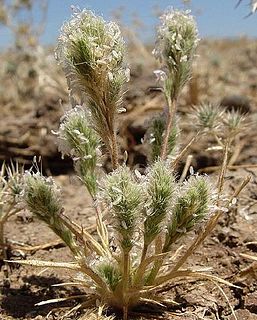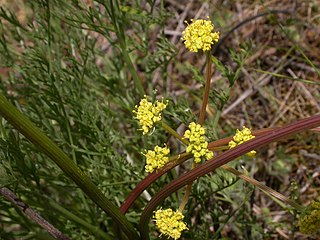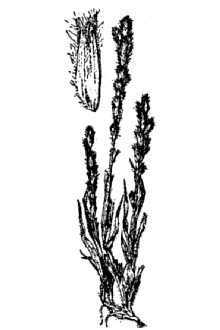The grass Tuctoria mucronata, which is known by several common names including prickly spiralgrass, Solano grass, and Crampton's tuctoria, is a federally listed endangered plant species endemic to two counties in northern California.

Pogogyne abramsii is a rare species of flowering plant in the mint family known by the common name San Diego mesa mint.

Limnanthes vinculans, the Sebastopol meadowfoam, is an endangered species of meadowfoam found only in the Laguna de Santa Rosa in Sonoma County, California, United States and an area slightly to the south in the Americano Creek and Washoe Creek watersheds. The name vinculans derives from the Latin root vinculum, meaning "a bond, a cord." The specific epithet vinculans means linking or bonding, in reference to the sharing of some characters of L. vinculans with L. douglasii (R.Br) and L. bakeri.

Lasthenia conjugens, commonly known as Contra Costa goldfields, is an endangered species of wildflower endemic to a limited range within the San Francisco Bay Area of the state of California, USA. Specifically this rare species occurs in Napa, Santa Barbara, Solano, Contra Costa, Santa Clara, Monterey and Alameda Counties. This annual herb typically flowers from March through June, and its colonies grow in vernal pool habitats at elevations not exceeding 100 meters above sea level. The Jepson Manual notes that the present distribution is limited to the deltaic Sacramento Valley, principally Napa and Solano Counties, but the historic range of L. conjugens is known to be significantly wider. In any case, historically the range has included parts of the North Coast, Sacramento Valley, and San Francisco Bay Area as well as the South Coast. Alternatively and less frequently this taxon has been referred to as Baeria fremontii var. conjugens.

Neostapfia is a genus of endemic Californian bunchgrasses, in the subfamily Chloridoideae of the grass family, Poaceae. The only known species is Neostapfia colusana, with the common name Colusa grass.

Lasthenia burkei is a rare species of flowering plant in the daisy family known by the common names Burke's goldfields and Burke's baeria.

Tuctoria greenei is a species of grass endemic to California. Its common names include awnless spiralgrass and Greene's tuctoria. It is included by the California Native Plant Society on list 1B.1. It is also listed by the state of California as rare and by the Federal Government as endangered, having been federally listed on March 26, 1997.

Orcuttia tenuis, the slender Orcutt grass, is a species of grass which is endemic to northern California.
Blennosperma bakeri is a rare species of flowering plant in the daisy family known by the common names Baker's stickyseed and Sonoma sunshine.
Euphorbia hooveri is a species of euphorb known by the common names Hoover's sandmat and Hoover's spurge. It is endemic to California, where it grows in the rare vernal pools of the Central Valley. Due to the elimination of most of its habitat, it became a federally listed threatened species in 1997.

Chloropyron molle is a species of flowering plant in the family Orobanchaceae.

Limnanthes floccosa, or woolly meadowfoam, is a species of meadowfoam found in Northern California and Southern Oregon, in the United States. Most of the subspecies have highly restricted distributions and are listed as critical or endangered.

Tuctoria is a genus of three species of grass in the family Poaceae. Spiralgrass is a common name for plants in this genus. These are bunchgrass species that are found in vernal pools of central California and Baja California, Mexico. The plants are annuals that germinate under water in the spring and grow submerged for weeks. After the pools dry down, the grasses initiate a new set of foliage that lasts for one to two months until flowering and fruiting are complete.

Orcuttia is a genus of grass in the family Poaceae. Plants grow up to 20 cm (8 in) tall, usually with many stems emerging from the base of the plant, and forming a tuft. The spikelets are several-flowered, with reduced upper florets. The lemma tips have between two and five teeth.

Navarretia leucocephala is a species of flowering plant in the phlox family known by the common name whitehead pincushionplant, or whitehead navarretia. It is native to North America, including much of the western United States and central Canada. It generally grows in wet or moist terrestrial habitat such as vernal pools.

Orcuttia californica is a rare species of grass known by the common name California Orcutt grass.
Orcuttia inaequalis is a rare species of grass known by the common name San Joaquin Valley Orcutt grass.

Orcuttia viscida is a rare species of grass known by the common name Sacramento Orcutt grass.

Poa napensis is a rare species of grass known by the common name Napa bluegrass. It is endemic to Napa County, California, where it is known from only two occurrences near Calistoga. It grows in moist, mineral-rich soil around hot springs. The rare grass only occurs on private, unprotected land and depends on water from the hot springs; changes to the local water regime or any other aspects of its specific habitat type would affect the plant. This grass was federally listed as an endangered species in 1997, along with another rare local hot spring endemic, the Calistoga popcornflower.

Lomatium cookii is a rare species of flowering plant in the carrot family known by the common names Cook's lomatium and agate desertparsley. It is endemic to Oregon in the United States, where it grows in only two valleys. It is a federally listed endangered species.















